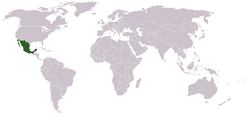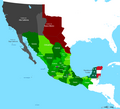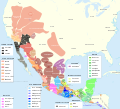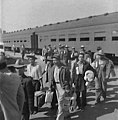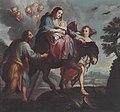Portal:Mexico
|
The Temple of Warriors at Chichen Itza, Mexico
¡Bienvenido! Welcome to the Mexico portal
Mexico, officially the United Mexican States, is a country in the southern portion of North America. It covers 1,972,550 km2 (761,610 sq mi), making it the world's 13th-largest country by area; with a population of almost 130 million, it is the 10th-most-populous country and the most populous Spanish-speaking country. Mexico is organized as a federal constitutional republic comprising 31 states and Mexico City, its capital. It shares land borders with the United States to the north, with Guatemala and Belize to the southeast; as well as maritime borders with the Pacific Ocean to the west, the Caribbean Sea to the southeast, and the Gulf of Mexico to the east.
This is a Featured article, which represents some of the best content on English Wikipedia.
 Baja California is a state in Northwest Mexico that is divided into seven municipalities. According to the 2020 Mexican census, Baja California is the 13th most populous state with 3,769,020 inhabitants and the 12th largest by land area spanning 73,290.08 square kilometres (28,297.46 sq mi). Municipalities in Baja California are administratively autonomous of the state according to the 115th article of the 1917 Constitution of Mexico. Their legal framework derives from Title VI of the state Constitution and the state's 2001 Law of the Municipal Regime. Every three years, citizens elect a municipal president (Spanish: presidente municipal) by a plurality voting system who heads a concurrently elected municipal council (ayuntamiento) responsible for providing public services for their constituents. The municipal council consists of a variable number of trustees and councillors (regidores y síndicos) who govern from the municipal seat. Municipalities are responsible for public services (such as water and sewerage), street lighting, public safety, traffic, and the maintenance of public parks, gardens and cemeteries. They may also assist the state and federal governments in education, emergency fire and medical services, environmental protection and maintenance of monuments and historical landmarks. Since 1984, they have had the power to collect property taxes and user fees, although more funds are obtained from the state and federal governments than from their own income. Municipalities may establish functional and geographical subdivisions called delegaciones and subdelegaciones in accordance with Article 29 of the Law of the Municipal Regime. (Full article...)Selected article -The Mexican War of Independence (Spanish: Guerra de Independencia de México, 16 September 1810 – 27 September 1821) was an armed conflict and political process resulting in Mexico's independence from the Spanish Empire. It was not a single, coherent event, but local and regional struggles that occurred within the same period, and can be considered a revolutionary civil war. It culminated with the drafting of the Declaration of Independence of the Mexican Empire in Mexico City on September 28, 1821, following the collapse of royal government and the military triumph of forces for independence. Mexican independence from Spain was not an inevitable outcome of the relationship between the Spanish Empire and its most valuable overseas possession, but events in Spain had a direct impact on the outbreak of the armed insurgency in 1810 and the course of warfare through the end of the conflict. Napoleon Bonaparte's invasion of Spain in 1808 touched off a crisis of legitimacy of crown rule, since he had placed his brother Joseph on the Spanish throne after forcing the abdication of the Spanish monarch Charles IV. In Spain and many of its overseas possessions, the local response was to set up juntas, ruling in the name of the Bourbon monarchy. Delegates in Spain and overseas territories met in Cádiz — a small corner of the Iberian Peninsula still under Spanish control — as the Cortes of Cádiz, and drafted the Spanish Constitution of 1812. That constitution sought to create a new governing framework in the absence of the legitimate Spanish monarch. It tried to accommodate the aspirations of American-born Spaniards (criollos) for more local control and equal standing with Peninsular-born Spaniards, known locally as peninsulares. This political process had far-reaching impacts in New Spain during the independence war and beyond. Pre-existing cultural, religious, and racial divides in Mexico played a major role in not only the development of the independence movement but also the development of the conflict as it progressed. (Full article...)Selected pictureThis is a Good article, an article that meets a core set of high editorial standards.
Nazario Moreno González (8 March 1970 – 9 March 2014), commonly referred to by his alias El Chayo ("Nazario" or "The Rosary") and/or El Más Loco ("The Craziest One"), was a Mexican drug lord who headed La Familia Michoacana before heading the Knights Templar Cartel, a drug cartel headquartered in the state of Michoacán. He was one of Mexico's most-wanted drug lords. Very few details are known of Moreno González's early life, but the authorities believe that religion played a major role in his upbringing. Although born in Michoacán, Moreno González moved to the United States as a teenager, but fled back into Mexico about a decade later to avoid prosecution on drug trafficking charges. In 2004, the drug boss Carlos Rosales Mendoza was captured, and Moreno González, alongside José de Jesús Méndez Vargas, took control of La Familia Michoacana. Unlike other traditional drug trafficking organizations in Mexico, his organization also operated like a religious cult, where its own members were given "bibles" with sayings and conduct guidelines. Moreno González reportedly carried out several philanthropic deeds to help the marginalized in Michoacán. Such deeds helped him craft an image of protector, saint, and Christ-like messianic figure among the poor, and gave La Familia Michoacana a level of influence among some natives. (Full article...)Selected biography -Benito Pablo Juárez García (Spanish: [beˈnito ˈpaβlo ˈxwaɾes ɣaɾˈsi.a] ⓘ; 21 March 1806 – 18 July 1872) was a Mexican Liberal lawyer and statesman who served as the 26th president of Mexico from 1858 until his death in office in 1872. Of Zapotec ancestry, he was the first and only indigenous president of Mexico and the first democratically elected indigenous president in the postcolonial Americas. Previously, he had served as Governor of Oaxaca and had later ascended to a variety of federal posts including Secretary of the Interior, Secretary of Public Education, and President of the Supreme Court. During his presidency he led the Liberals to victory in the Reform War and in the Second French intervention in Mexico. Born in Oaxaca to a poor, rural, Indigenous family and orphaned as a child, Juárez passed under the care of his uncle, eventually moving to Oaxaca City at the age of 12, where he found work as a domestic servant. Sponsored by his employer who was also a lay Franciscan, Juárez temporarily enrolled in a seminary and studied to become a priest, but he later switched his studies to law at the Institute of Sciences and Arts, where he became active in Liberal politics. He began to practice law and was eventually appointed as a judge, after which he married Margarita Maza, a woman from a socially distinguished family in Oaxaca City. (Full article...)
In the news
Selected fare or cuisine - A calavera (Spanish – pronounced [kalaˈβeɾa] for "skull"), in the context of Day of the Dead, is a representation of a human skull or skeleton. The term is often applied to edible or decorative skulls made (usually with molds) from either sugar (called Alfeñiques) or clay, used in the Mexican celebration of the Day of the Dead (Spanish: Día de Muertos) and the Roman Catholic holiday All Souls' Day. Calavera can also refer to any artistic representations of skulls or skeletons, such as those in the prints of José Guadalupe Posada, or to gifts or treats in relation to the Day of the Dead. Some widely known calaveras are created with cane sugar, decorated with items such as colored foil, icing, beads, and sometimes objects such as feathers. They range in multiple colors. Traditional methods for producing sugar skulls with molds have been in use for a long time, though the first known mention of the sale of skeletal figures dates to the 1740s. The sugar skulls were originally created as gifts, to be eaten by children. They are sometimes now used as offerings to be placed on altars known as ofrendas ("offerings") for Día de Muertos. It has been argued that the tradition has roots in indigenous celebrations, by groups including the Aztec, Mayan, and Toltec commemorations. However, what we now call Day of the Dead is more Catholic than indigenous because the Spanish tried to eradicate indigenous religions Moreover, as Stanley Brandes has argued, these skulls and skeletons have seven characteristics. They are: (1) ephemeral; (2) seasonal; (3) humorous; (4) secular; (5) commercial; (6) made for living people; (7) meant to be played with; (8) small and transportable; (9) made and consumed by an urban population. They are "lighthearted emblems of death." Thus they are not derived from sacred Mesoamerican traditions. (Full article...)
General imagesThe following are images from various Mexico-related articles on Wikipedia.
CategoriesTopicsRelated portalsWikiProjectYou are invited to participate in WikiProject Mexico, a WikiProject dedicated to developing and improving articles about Mexico. Associated WikimediaMore portals | ||||||||||




